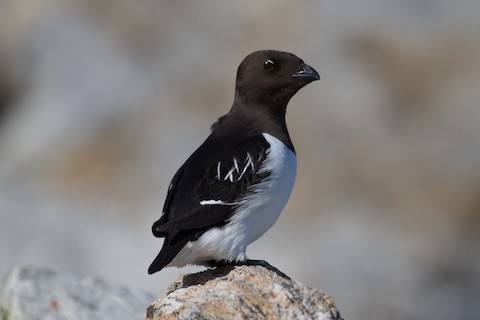Alcidae: Auks

Razorbill in flight. © A. Emmerson
Auks, or alcids, are plump seabirds that loosely combine features of ducks, pigeons, and gulls, and seem to be the Northern Hemisphere’s counterpart to penguins. The best-known members of the family are the three species of puffins, which are famous for their improbable, candy-colored, semicircular bills, and the Great Auk (Pinguinus impennis), which is famous for having been flightless and therefore readily harvested to extinction, and as its scientific name suggests, was the original recipient of the name “penguin.”
Alcids range in size from the goose-sized Great Auk down to the sparrow-sized Least Auklet (Aethia pusilla). Most have the approximate size and body-shape of a duck or pigeon and resemble penguins, except that all living alcids retain the power of flight.

Dovekie or Little Auk. © Tom Bedford
Most alcids nest colonially on islets and sea cliffs that are inaccessible to terrestrial predators, but a few use different strategies. Perhaps the most surprising is the placement of nests high in the canopy of old growth forests, an approach adopted by multiple species of murrelets.
Alcids reach maximum diversity in Beringia—with the peak at Buldir Island in the outer Aleutians, where twelve alcid species nest together.
Taxonomy
The Alcidae consists of two major lineages that are widely regarded as subfamilies:
Aethiinae: Puffins and auklets (9 species)
Alcinae: Auks and murres (15 or 16 species, plus 1 extinct)
The family as a whole thus comprises 24 or 25 species, plus 1 extinct.
Rhinoceros Auklet (Cerorhinca monocerata)
Tufted Puffin (Fratercula cirrhata)
Atlantic Puffin (Fratercula arctica)
Horned Puffin (Fratercula corniculata)
Cassin’s Auklet (Ptychoramphus aleuticus)
Crested Auklet (Aethia cristatella)
Least Auklet (Aethia pusilla)
Whiskered Auklet (Aethia pygmaea)
Parakeet Auklet (Aethia psittacula)
Long-billed Murrelet (Brachyramphus perdix)
Marbled Murrelet (Brachyramphus marmoratus)
Kittlitz’s Murrelet (Brachyramphus brevirostris)
Black Guillemot (Cepphus grylle)
Spectacled Guillemot (Cepphus carbo)
Pigeon Guillemot (Cepphus columba)
“Pigeon Guillemot” (C. c. columba)
“Kuril Guillemot” (C. c. snowi)
Thick-billed Murre (Uria lomvia)
Great Auk (Pinguinus impennis) †
Ancient Murrelet (Synthliboramphus antiquus)
Japanese Murrelet (Synthliboramphus wumizusume)
Craveri’s Murrelet (Endomychura craveri)
Scripps’s Murrelet (Endomychura scrippsi)
Guadalupe Murrelet (Endomychura hypoleuca)
References
Boyd, J.H., 2021. Taxonomy in Flux: Gruae II: Charadriiformes. http://jboyd.net/Taxo/List9a.html. (Posted October 6, 2021; Accessed January 4, 2022.)
Gaston, A.J., and I.L. Jones. 1998. The Auks: Alcidae. Oxford University Press.
Howell, S.N.G., and K. Zufelt. 2019. Oceanic Birds of the World. Princeton University Press.
Hume, J.P. 2017. Extinct Birds (Second Edition). Bloomsbury Publishing PLC, London.
Roberson, D. 2009. Bird Families of the World: Alcids, Alcidae, http://creagrus.home.montereybay.com/alcids.html. (Posted August 2, 2009. Accessed January 4, 2022.)
Text © Russell Fraker / January 4, 2022